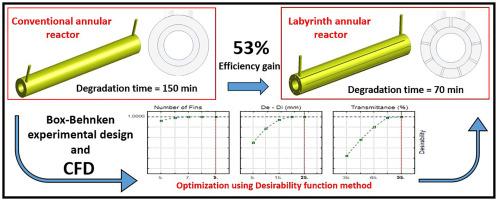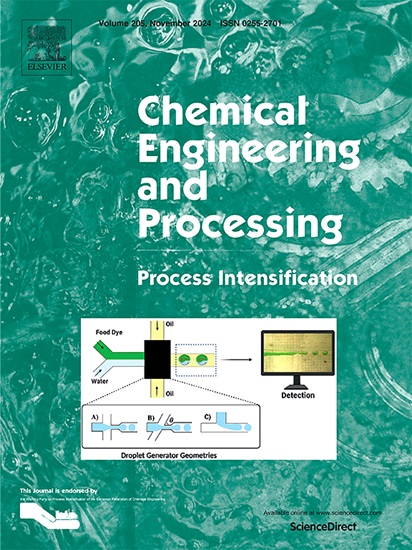利用 cfd 模拟和优化方法对固定催化剂光催化反应器处理新污染物水的性能分析
IF 3.8
3区 工程技术
Q3 ENERGY & FUELS
Chemical Engineering and Processing - Process Intensification
Pub Date : 2024-10-01
DOI:10.1016/j.cep.2024.110016
引用次数: 0
摘要
通过将 CFD 建模和箱-本肯实验设计相结合,并采用可取函数法进行优化,对环形迷宫光催化反应器的设计进行了优化,以降解水中新出现的污染物。通过改变实验设计中的三个因素,即迷宫中的鳍片数量、环形区域的厚度和溶液透过率,使污染物降解时间和反应器运行成本最小化,从而进行了优化。变化范围分别为 5 至 9、5 毫米至 25 毫米以及 35% 至 95%。CFD 模拟中使用的水杨酸降解内在动力学模型考虑了污染物浓度和光照强度的变化。结果表明,透光率是使降解时间和能源成本最小化的最重要因素,其次是环形反应器厚度和翅片数量。可取性方法显示,优化反应器水平的组合为 9 个鳍片、25 毫米厚度和 95% 的透射率。为了验证优化反应器的增效效果,比较了优化反应器与传统环形反应器的降解时间和能源成本。效率提高了约 53%。本文章由计算机程序翻译,如有差异,请以英文原文为准。

Performance analysis of photocatalytic reactor with immobilized catalyst for emerging pollutants water treatment using cfd simulation and optimization method
An annular labyrinth photocatalytic reactor design was optimized to degrade water emerging pollutants by combining CFD modeling and a Box-Benken experimental design with the desirability function method for the optimization. The optimization was performed by minimizing the pollutant degradation time and the reactor operational cost, varying three factors in the experimental design, the fins number in the labyrinth, the thickness of the annular region, and the solution transmittance. The range of variation levels was 5 to 9, 5 mm to 25 mm, and 35 % to 95 % respectively. The intrinsic kinetic model of the salicylic acid degradation used in CFD simulations takes into account the variations of pollutant concentration and light intensity. Results showed that the transmittance was the most significant factor in minimizing both degradation time and energy cost, followed by the annular reactor thickness and the fins number. The desirability method showed that the combination of the optimized reactor levels was 9 fins, thickness of 25 mm, and transmittance of 95 %. To verify the efficiency gain of the optimized reactor, it was compared the degradation time and the energy cost of the optimized reactor with a conventional annular reactor. The efficiency gain was about 53 %.
求助全文
通过发布文献求助,成功后即可免费获取论文全文。
去求助
来源期刊
CiteScore
7.80
自引率
9.30%
发文量
408
审稿时长
49 days
期刊介绍:
Chemical Engineering and Processing: Process Intensification is intended for practicing researchers in industry and academia, working in the field of Process Engineering and related to the subject of Process Intensification.Articles published in the Journal demonstrate how novel discoveries, developments and theories in the field of Process Engineering and in particular Process Intensification may be used for analysis and design of innovative equipment and processing methods with substantially improved sustainability, efficiency and environmental performance.

 求助内容:
求助内容: 应助结果提醒方式:
应助结果提醒方式:


